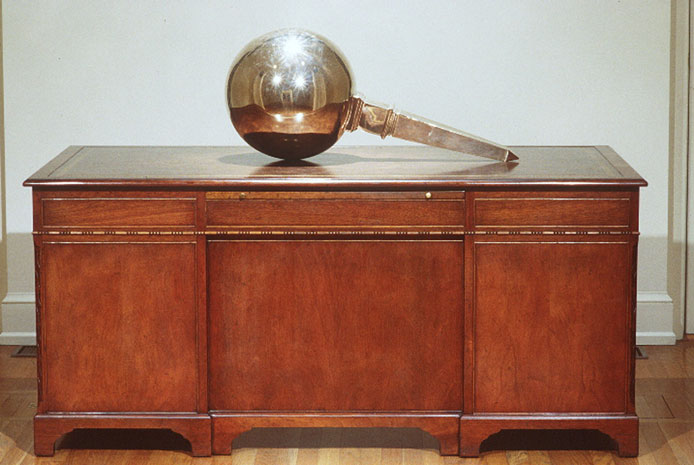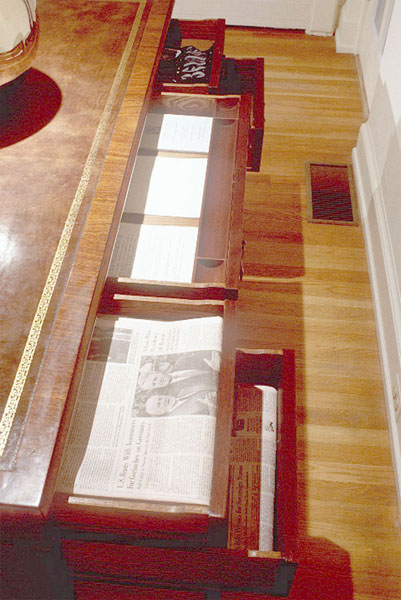
GOVERNMENTnature , 1990
Installation view: Baumgartner Galleries, Washington, D.C.
Desk 30 x 66 x 36 inches
Global Justice, 1989
Bronze, 15 x 36 x 15 inches

GOVERNMENTnature, 1990
Detail showing the summit information stored in the desk that
was collected during the month-long installation becoming
an archive.
Installation view: Baumgartner Galleries, Washington, D.C.
On May 30th 1990, the exhibition GOVERNMENTnature opened at Baumgartner Galleries, in Washington, D.C., exploring the relationship between politics and philosophical aesthetics. Invitations to the exhibitions contained an engraved card with only the word ‘GOVERNMENTnature’. They had been sent to most of Washington’s government officials to deliver the message of inadequate environmental policy. In the exhibition were several independent but interrelated sculptures united under the conceptual framework of the words ‘GOVERNMENT’ and ‘nature’ joined as one word, stressing the need to legislate for survival.
This work had begun in April of 19871 as a staged social process work that alternated attending White House Press briefings with solitary trips into nature along the California coast.2 For two weeks in the summer of 1987, the Reagan White House was stationed in Santa Barbara, and press briefings were attended with the uprooted Washington press corps. The subjects of the briefings were primarily related to Soviet-U.S. relations,3 the possibility of a more peaceful world and a planned visit to Washington.4 In contrast, various hikes in the wilderness were spent in focused observation, with all the senses, of mountains, forests and beaches. A number of nights were spent outside, followed by the drive back to Santa Barbara in the morning in time to attend the next briefing. The artwork enabled a closer study of two very different types of existence and knowing.
The practice was to read the newspapers, attend the briefing, and journey again to the natural areas along the central coast of California along Highway 1 walking into the aromatic Santa Lucia Mountains or on the beaches of Big Sur. Hikes took place in storms and powerful winds, in dry heat and milky-gray light. By the end of the two weeks, boundaries of experiences had dissolved and interrelatedness had taken place. Journalists engaged in discussions about the state of the environment, and a correspondent for the Washington Post volunteered to carry two palm fronds collected from Big Sur (wrapped in newspaper, the fronds looked like rifles) aboard Air Force One to stimulate conversation about the state of the environment and protocols of peace vs. militaristic agendas. He was asked to unwrap them, which began the on-board discussions.
1April 1987 was the first anniversary of Operation El Dorado Canyon. The United States’ war on terrorism was then with Libya, and direct orders from the White House had been to conduct strategic air strikes on Libya with the intention (for said national security reasons) to assassinate Qaddafi. (It didn’t work.)
2I had obtained a guest pass to attend the summer White House briefings held in Santa Barbara, California, which is where they took place while President Reagan was at his ranch in the hills of Santa Barbara County.
3Information archiving the time can be read at: Ronald Reagan’s (President of the United States: 1981-1989) Radio Address to the Nation on Soviet-United States Relations, 18 April, 1987. Available at: http://www.presidency.ucsb.edu/ws/index.php?pid=34128 (Woolley and Peters, no date)
4In December Gorbachev visited Washington and signed a treaty banning intermediate-range missiles.